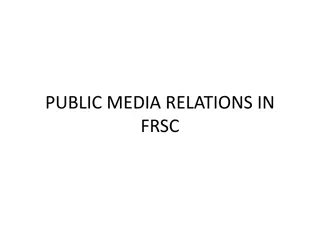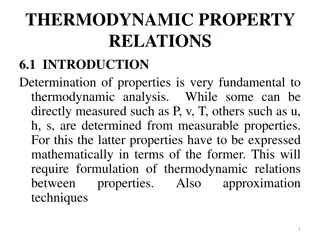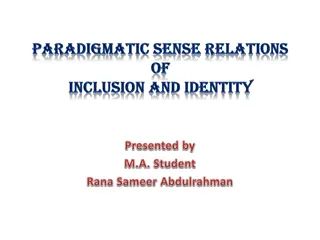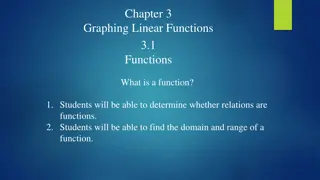Understanding Relations and Functions in Mathematics
A relation is a correspondence between two sets where each element in the first set (domain) corresponds to at least one element in the second set (range). Functions are special relations where each element in the domain has a unique correspondence in the range. Surjective functions map the entire range, injective functions have unique mappings, and bijective functions are both injective and surjective. The natural domain of a function is the set of input values for which the function is defined. Translations involve shifting graphs vertically or horizontally.
Download Presentation

Please find below an Image/Link to download the presentation.
The content on the website is provided AS IS for your information and personal use only. It may not be sold, licensed, or shared on other websites without obtaining consent from the author. Download presentation by click this link. If you encounter any issues during the download, it is possible that the publisher has removed the file from their server.
E N D
Presentation Transcript
A RELATION Consider the relationship between the weight of five students and their ages as shown below. We can represent this information as a set of ordered pairs. An age of 10 years would correspond to a weight of 31 kg. An age of 16 years would correspond to a weight of 53 kg and so on. This type of information represents a relation between two sets of data. This in formation could then be represented as a set of ordered pairs. Age (years) 10 12 14 16 18 Weight (kg) 31 36 48 53 65 {( 10,31),( 12,36),( 14,48),(16,53),(18,65)} The set of all first elements of the ordered pair is called the domain of the relation and is referred to as the independent variable. The set of all second elements is called the range and is referred to as the dependent variable. For the above example, the domain = {10,12,14,16,18} the range = {31,36,48,53,65} Summary corresponds to ? value ? value defining relationship Domain Range [Independent variable] [Dependent variable]
A RELATION Relation A relation is a correspondence between a first set, called the domain, and a second set, called the range, such that each member of the domain corresponds to at least one member of the range. A relation is any subset of the Cartesian plane and can be represented by a set of ordered pairs ?,? .
B FUNCTIONS Functions are special relations. Every set of ordered pairs is a relation, but every relation is not a function Functions make up a subset of all relations. A function is defined as a relation that is either one to one or many to one., i.e. no ordered pairs have the same first element.
B TYPES OF FUNCTIONS
Surjective A surjective function is a function whose image is equal to its codomain. Equivalently, a function ? with domain ? and codomain ? is surjective if for every ? in ? there exists at least one ? in ? with ? ? = ?. If : , then is said to be surjective if: , such that ( ) . b B a A f a b = f A B f Injective A function ? is injective if and only if for all ? and ? in ?, if ? ? = ?(?), then ? = ?; that is, ? ? = ?(?) implies ? = ?. Equivalently, if ? ?, then ?(?) ?(?). If : , then is said to be injective if: , ( ) ( ) . a b A if f a f b a b = = f A B f Bijective A function is bijective (one-to-one and onto or one-to-one correspondence) if every element of the codomain is mapped to by exactly one element of the domain. (That is, the function is both injective and surjective.)
C NATURAL DOMAIN Every relation has a domain, the set of (input) values over which it is defined. If the domain is not stated, by convention we take the domain to be the largest set of (real) numbers for which the expression defining the function can be evaluated. We call this the "natural domain" of the function. Domain Range
D TRANSLATIONS Shift upward of downward Shift to the right or left ? ? + ?translates ? ? vertically a distance of ? units upward. ? ? + ?translates ? ? horizontally a distance of ? units to the left, when ? > 0. ? ? ?translates? ?vertically a distance of ? units downward. ? ? ?translates ? ? horizontally a distance of ? units to the right, when ? > 0.
D TRANSLATIONS Reflections ? ?reflects ? ? in the ? axis. ? ?reflects ? ? in the ? axis.
D TRANSLATIONS Stretches A stretch with a scale factor ? where 0 < ? < 1 will actually compress the graph. ? ??stretches or compresses ? ? horizontally with scale factor1 ?? ?stretches ? ? vertically with a scale factor of ?. ?. Students often make mistakes with stretches. It is important to remember the different effects of, for example, 2?(?) and ? 2? . The transformation is a vertical stretch of scale factor ?. When ? > 1 the graph stretches away from the ? axis. When 0 < ? < 1 the graph is compressed towards the ? axis. The transformation is a horizontal stretch of scale factor 1 When ? > 1 the graph is compressed towards the ? axis. When 0 < ? < 1 the graph is compressed away from the ? axis. ?.










































